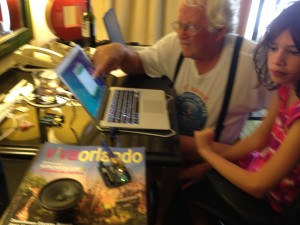I recently went on a trip with my dad, Poppa John and my youngest daughter Ana. This was the first time I traveled with my daughter separately from the family. She negotiated this trip to Disney World for spring break and was quite persuasive. That said, I knew I wasn’t going to spend every day for a week at a Disney theme park. Ana is very interested in technology – she’s the daughter who wants to learn to code, immerses herself in Minecraft and has participated in app development summer programs. Our entire family encourages this and Poppa John indulges her. For this trip, Poppa John purchased a couple of Arduinos for us to play with during some downtime. He also compiled a selection of really cool things that Arduinos can be used for and got a book for kids, written by a kid on how to program our Arduino.
My husband is the programmer of the family. He started when he was 14 and has made this his career for the last 20+ years. I have had a much more diverse career supporting technology – project and product manager, analyst, customer success manager and software team lead. To my father, I was sitting on the fringe of women in tech and needed to get motivated to lead Ana on her quest. If we sat around waiting for Carson it would be slow going. These Arduino projects we had planned were as much for Ana’s benefit as it was for me to step up to the challenge.
Our downtime fun started a bit slow, with Ana not really understanding what an Arduino was and why she should care. Her attitude swung to the other extreme once she figured out that she could build a car with lights and sounds. However, she just didn’t understand why she had to do the basic lessons and not jump straight to the car. Since Ana doesn’t like to be left out, Poppa John and I started connecting the Arduino and making it light up and sing. This at least got Ana creeping over to the computer and looking over our shoulders. We knew we had her attention at least for a little while when she took her spot front and center on Poppa John’s lap.
We took a very simple approach to this, using the existing open community scripts for making the light blink or the song play. We then took the next logical steps to add blinking loops, change the speed of the blink or the manipulating the time between the blinks, slowly making the code a bit more complicated. I took my pretty standard approach of asking Ana the engaging questions, but having her work out the details with Poppa John. I also stepped in to help troubleshoot or explain something when mistakes were made.
It was during this time that Poppa John was surprised. He claimed I was holding out on my women in technology-ness. How was it that I could never have had coded anything (expect sql during my brief DBA days) but yet could read the code and make suggestions and resolve issues? In each one of my diverse opportunities working for technology companies, I have always been hands-on. When issues arise in my projects, I worked very closely with my technical team to walk through the business requirements and the code to figure out the best way to resolve these issues. I have always been willing to lend a helping hand and truly get my hands dirty. Apparently I have picked up a few technical skills.
We ended up having a lot of fun with something new. We made our Arduino blink SOS and play music. We also turned the Arduino into a finger flute. Ana still wants to build her car and thinks it’s pretty cool. Ultimately, I taught my father that I was a women in technology and had the skills to teach my daughter to be one too (in any capacity she wants).
